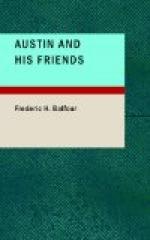“By the way, there’s still one room you haven’t seen,” remarked St Aubyn, as they were strolling at their leisure through the grounds. “We call it the Banqueting Hall—in that wing between the two old towers. Queen Elizabeth was entertained there once, and it contains some rather beautiful tapestries. I should like to have them moved into the main building, only there’s really no place where they’d fit, and perhaps it’s better they should remain where they were originally intended for. Are you fond of tapestry?”
“I’ve never seen any,” said Austin, “but of course I’ve read about it—Gobelin, Bayeux, and so on. I should love to see what it looks like in reality.”
“Come, then,” said St Aubyn, crossing the lawn. “I have the key in my pocket.”
He flung open the door. Austin found himself in the vast apartment, groined and vaulted, measuring about a hundred and twenty feet by fifty, and lighted by exquisite pointed windows enriched with coats-of-arms and other heraldic devices in jewel-like stained glass. The walls were completely hidden by tapestries of rare beauty, woven into the semblance of gardens, palaces, arcades and bowers of clipped hedges and pleached trees with slender fountains set meetly in green shade; while some again were crowded with swaying Gothic figures of saints and kings and warriors and angels, all far too beautiful, thought Austin, to have ever lived. Yet surely there must be some prototypes of all these wonderful conceptions somewhere. There must be a world—if we could only find it—where loveliness that we only know as pictured exists in actual reality. What a dream-like hall it was, on that still summer afternoon. Yet there was something uncanny about it too. St Aubyn had stepped out of sight, and Austin left by himself began




